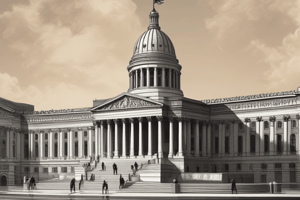Podcast
Questions and Answers
Which principle is central to the theory of Originalism regarding constitutional interpretation?
Which principle is central to the theory of Originalism regarding constitutional interpretation?
- Adapting the Constitution to contemporary societal values.
- Prioritizing international legal norms over domestic constitutional law.
- Interpreting the Constitution based on the perceived intentions of current political leaders.
- Adhering to the understanding of the Constitution at the time of its drafting. (correct)
How does Living Constitutionalism differ from Originalism in interpreting the Constitution?
How does Living Constitutionalism differ from Originalism in interpreting the Constitution?
- Living Constitutionalism is concerned with the economic implications of constitutional law, while Originalism focuses on social impacts.
- Living Constitutionalism strictly adheres to the literal text of the Constitution, while Originalism considers historical context.
- Living Constitutionalism allows for evolving interpretations of the Constitution, while Originalism seeks to maintain its original meaning. (correct)
- Living Constitutionalism requires frequent formal amendments to the Constitution, unlike Originalism.
What is a critique of Living Constitutionalism?
What is a critique of Living Constitutionalism?
- It overly restricts the government's ability to address modern issues.
- It risks interpreting the law based on desired outcomes rather than the text's actual meaning. (correct)
- It makes the Constitution too rigid and inflexible to societal changes.
- It ignores the historical context in which the Constitution was written.
According to the 'departmental' view of constitutional interpretation, who has the authority to interpret the constitution?
According to the 'departmental' view of constitutional interpretation, who has the authority to interpret the constitution?
What was Alexander Hamilton's argument in Federalist 78 regarding the judiciary?
What was Alexander Hamilton's argument in Federalist 78 regarding the judiciary?
According to Hamilton in Federalist 78, what is the role of judicial review?
According to Hamilton in Federalist 78, what is the role of judicial review?
According to Hamilton, why is life tenure important for judges?
According to Hamilton, why is life tenure important for judges?
Which of the following best describes a bureaucracy?
Which of the following best describes a bureaucracy?
What is the primary function of the federal bureaucracy?
What is the primary function of the federal bureaucracy?
How did the Pendleton Act of 1883 change the federal government?
How did the Pendleton Act of 1883 change the federal government?
Which event led to the first surge in the size of the federal bureaucracy?
Which event led to the first surge in the size of the federal bureaucracy?
Which of the following programs was created during the Great Society era?
Which of the following programs was created during the Great Society era?
Which is considered an original department within the structure of the federal bureaucracy?
Which is considered an original department within the structure of the federal bureaucracy?
Which cabinet department is responsible for advising the President on foreign policy?
Which cabinet department is responsible for advising the President on foreign policy?
Which of the following describes a clientele department?
Which of the following describes a clientele department?
Which cabinet department manages public lands, national parks, and wildlife refuges?
Which cabinet department manages public lands, national parks, and wildlife refuges?
The Department of Housing and Urban Development (HUD) is primarily focused on?
The Department of Housing and Urban Development (HUD) is primarily focused on?
What distinguishes regulatory commissions from cabinet departments?
What distinguishes regulatory commissions from cabinet departments?
Why are heads of regulatory commissions given relatively long and overlapping terms?
Why are heads of regulatory commissions given relatively long and overlapping terms?
The concept of 'cruel and unusual punishment' evolving over time is an argument supporting which theory of constitutional interpretation?
The concept of 'cruel and unusual punishment' evolving over time is an argument supporting which theory of constitutional interpretation?
What is the main role of the Department of Transportation (DOT)?
What is the main role of the Department of Transportation (DOT)?
The Department of Education is responsible for?
The Department of Education is responsible for?
What is the role of the Department of Homeland Security?
What is the role of the Department of Homeland Security?
An agency that regulates meat, poultry, and processed eggs falls under the purview of which department?
An agency that regulates meat, poultry, and processed eggs falls under the purview of which department?
Which of these regulatory commissions is responsible for developing, implementing, and adjudicating policy in its area of responsibility?
Which of these regulatory commissions is responsible for developing, implementing, and adjudicating policy in its area of responsibility?
Flashcards
Originalism
Originalism
A theory of constitutional interpretation emphasizing the original understanding at the time of writing.
Living Constitutionalism
Living Constitutionalism
A theory viewing the Constitution as adaptable and evolving to modern circumstances.
Judicial Review
Judicial Review
The power of the courts to invalidate laws that conflict with the Constitution.
Departmental view of constitutional interpretation
Departmental view of constitutional interpretation
Signup and view all the flashcards
Hamilton's View of the Judiciary
Hamilton's View of the Judiciary
Signup and view all the flashcards
Arguments for Life Tenure
Arguments for Life Tenure
Signup and view all the flashcards
Bureaucracy
Bureaucracy
Signup and view all the flashcards
Federal Bureaucracy
Federal Bureaucracy
Signup and view all the flashcards
Patronage
Patronage
Signup and view all the flashcards
Pendleton Act of 1883
Pendleton Act of 1883
Signup and view all the flashcards
First Surge in Federal Employment
First Surge in Federal Employment
Signup and view all the flashcards
Second Surge in Federal Employment
Second Surge in Federal Employment
Signup and view all the flashcards
Original Departments
Original Departments
Signup and view all the flashcards
Clientele Departments
Clientele Departments
Signup and view all the flashcards
Service Departments
Service Departments
Signup and view all the flashcards
Regulatory Commissions
Regulatory Commissions
Signup and view all the flashcards
Study Notes
- Judicial Interpretation involves different theories on how to interpret the US Constitution.
Originalism
- Theory of constitutional interpretation that seeks to understand the Constitution as it would have been understood when it was written.
- Decisions made by the Supreme Court should align with the literal definitions and language used in the document in 1789.
- Originalists believe the Constitution should have a fixed meaning.
Living Constitutionalism
- Theory that views the US Constitution as having a dynamic meaning that evolves and adapts to changing circumstances, even without formal amendments.
- Argues that the Constitution is silent on the matter of constitutional interpretation.
- Living constitutionalists suggest that if the framers wanted future generations to interpret the Constitution in a specific way, they would have stated it explicitly.
- A criticism is that it can lead to the law being twisted to fit desired outcomes, potentially reading rights into the Constitution.
- Another criticism is that the original designers provided a means of amending it, they never intended for their original words to change the meaning, noting how difficult it is to amend the constitution.
Jefferson’s Criticism
- Jefferson agreed that laws conflicting with the Constitution should be invalidated.
- He believed each government department should have a role in judicial review.
- Jefferson argued that the Supreme Court should not have a monopoly on interpreting the Constitution.
- Jefferson stated that judges are fallible and susceptible to partisan passions.
- Jefferson proposed judges be have reappointment every 6 years and can be appointed by president.
Federalist 78
- Hamilton argued the courts are the least dangerous branch, lacking the power of the purse (legislative) and the sword (executive).
- Hamilton stated that the judiciary is not superior to either congress or the people.
- Courts act as an intermediary to protect peoples’ rights from Congress.
- Life tenure ensures judicial independence, guarding against improper influence from the Executive or Legislature.
- A limited pool of qualified candidates necessitates life tenure to attract and retain talent.
- Life tenure checks Congress and safeguards judicial independence.
Bureaucracy
- A bureaucracy is a hierarchical organization with specialized offices and employees assigned responsibilities based on merit, knowledge, and experience.
- The federal bureaucracy includes all executive agencies, personnel, and federal government employees, tasked with administering and enforcing congressional laws.
Federal Bureaucracy Structure
- The structure consists of 15 major cabinet departments organized hierarchically.
- There are 12 independent regulatory commissions.
- There are dozens of major agencies, boards, and institutes.
- Bureaucrats are permanent government employees, often pursuing long-term public service careers.
- Systems prior to modern bureaucratic systems involved Patronage where political jobs were awarded based on political ties rather than qualifications.
- The federal bureaucracy's original tasks included delivering mail, collecting customs duties, and recording land deeds and marriage certificates.
- The Pendleton Act of 1883 replaced patronage with a merit-based system for federal government jobs.
Federal Bureaucracy Growth
- The federal bureaucracy grew from 100,000 workers in 1880 to 3 million in the late 1960s.
- The first major surge happened during the Great Depression in the 1930s with the New Deal, leading to the creation of the Social Security Administration (1935), US Securities and Exchange Commission (1934), and National Labor Relations Board (1935).
- The second surge occurred in the 1960s with the Great Society programs, creating Medicare (1965), Medicaid (1965), Head Start (1965), Department of Housing and Urban Development (1965), and Department of Transportation (1966).
Structure of the Federal Bureaucracy
- The original departments handle foundational governmental tasks like defense, law enforcement, and financial management.
- The Department of Justice includes sub-agencies like the FBI, DEA, and BOP.
- The Department of Defense includes the Army, Navy, and Marines.
- The Department of Treasury collects taxes, manages the national debt, and formulates economic policy.
- The Department of State advises the President on foreign policy, including relations with the UN, WHO, WTO, and USAID.
Clientele Departments
- Serving specific interests in society (agriculture, labor, veterans)
- USDA: Regulates meat, poultry, and egg products and supports farmers through loan programs.
- Department of Commerce aims to strengthen domestic industry, create jobs, ensure fair trade, and stimulate local economies.
- Department of Veteran Affairs provides benefits and services to veterans and their families, including education, health care, and home loans.
- Department of Labor administers and enforces federal laws related to minimum wage, workplace safety, unemployment insurance, and employment discrimination.
- Department of Interior manages public lands, national parks, and wildlife refuges.
Service Departments
- Departments offer broad social services that benefit the general population such as health, education, and housing.
- The Department of Health and Human Services oversees programs, funding, and research related to public health, food and drug safety, and health insurance, including the CDC, FDA, NIH, and CMS.
- The Department of Energy manages nuclear weapons, national energy security, and promotes energy efficiency.
- The Department of Homeland Security works to prevent and respond to domestic threats like terrorism, natural disasters, and border security.
- The Department of Housing and Urban Development facilitates affordable housing, manages public housing programs, and enforces fair housing laws.
- The Department of Transportation oversees transportation infrastructure development and sets safety regulations, including vehicle safety standards and the Federal Aviation Administration.
Regulatory Commissions
- Regulatory commissions are headed by bipartisan boards responsible for developing, implementing, and adjudicating policy.
- These commissions include the SEC, Federal Reserve, CPSC, FTC, and FCC.
- Headed by bipartisan boards with long, overlapping terms, insulating them from political influence.
- While the President appoints heads, they cannot be fired at will, ensuring further independence.
Studying That Suits You
Use AI to generate personalized quizzes and flashcards to suit your learning preferences.



